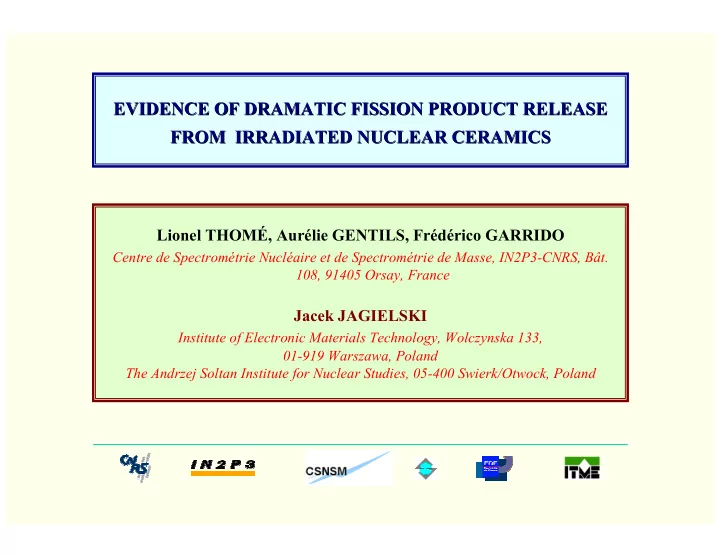

EVIDENCE OF DRAMATIC FISSION PRODUCT RELEASE EVIDENCE OF DRAMATIC FISSION PRODUCT RELEASE FROM IRRADIATED NUCLEAR CERAMICS FROM IRRADIATED NUCLEAR CERAMICS Lionel THOMÉ, Aurélie GENTILS, Frédérico GARRIDO Centre de Spectrométrie Nucléaire et de Spectrométrie de Masse, IN2P3-CNRS, Bât. 108, 91405 Orsay, France Jacek JAGIELSKI Institute of Electronic Materials Technology, Wolczynska 133, 01-919 Warszawa, Poland The Andrzej Soltan Institute for Nuclear Studies, 05-400 Swierk/Otwock, Poland
PURPOSE OF THE WORK 1 - To show the efficiency of ion beams for the evaluation of nuclear ceramics 2 - To present results concerning the diffusion and release of radiotoxic elements (fission products) in nuclear ceramics
USE OF ION BEAMS FOR THE USE OF ION BEAMS FOR THE EVALUATION OF NUCLEAR CERAMICS EVALUATION OF NUCLEAR CERAMICS
TOPICS STUDIED WITH ION BEAMS � Radiation effects FF (~100 MeV) � � � Fission Fragments particles α α α α α particles α α α α recoils α α α (~5 MeV) recoils α α α α (~100 keV) µ m 10 µ µ µ � Retention of radionuclides � � � Actinides Fission Products � Helium behavior � � � Helium location and retention Effects of He on materials properties
USE OF ION BEAMS IRRADIATION DOPING MATERIAL High-energy ions (100 MeV) stable elements Low-energy ions (100 keV) radioactive elements Retention of radionuclides Radiation effects He behavior CHARACTERIZATION RBS / ERDA / PIXE Nuclear reactions Channeling Radiation damage Atomic mobility
CSNSM accelerator Middleton electron ion source microscope IRMA Penning ion source Penning ion source clusters implantation characterization
RADIATION DAMAGE INDUCED BY ION IRRADIATION dpa 0 1 2 3 4 1.0 stage 3 ZrO 2 ACCUMULATED DAMAGE (f D ) 0.8 • Stage 1: Small isolated defect • • • RT clusters 0.6 • Stage 2: Transition from defect • • • stage 2 clusters to the linking of 800°C extended lattice defects 0.4 • Stage 3: Dislocations • • • 0.2 stage 1 0.0 0 2 4 6 8 10 FLUENCE (10 15 cm -2 ) Damage evolution in zirconia irradiated with 500 keV Ar ions
RETENTION OF RADIONUCLIDES RETENTION OF RADIONUCLIDES
EXPERIMENTAL APPROACH ION IMPLANTATION Cs ZrO 2 TRIM (300 keV) Cs ION DISTRIBUTION Incident Ions (100 keV–1 MeV) 300 K IONS MATRIX 0 20 40 60 80 100 120 140 DEPTH (nm) HIGH TEMPERATURE ANNEALING + HIGH TEMPERATURE IRRADIATION
ANALYSIS OF THE DEPTH DISTRIBUTION OF IMPLANTED IONS WITH RUTHERFORD BACKSCATTERING (RBS) implanted ions He (MeV) He (MeV) Matrix Matrix θ θ θ θ θ θ θ θ Ω Ω Ω Ω Ω Ω Ω Ω Counts Counts Energy Energy
30 2 Cs CONC. (at.%) Zr 1 NORMALIZED YIELD 0 20 150 100 50 0 DEPTH (nm) 10 Cs 0 380 400 420 440 CHANNEL RBS spectra on zirconia implanted with 300 keV Cs ions
EFFECT OF THE FISSION PRODUCT CONCENTRATION ON THE DIFFUSION 5 Cs CONCENTRATION (at.%) virgin ann. 500°C 4 ann. 650°C 3 high c 2 low c 1 0 0 20 40 60 80 100 120 140 DEPTH (nm) Modification of the FP depth profile upon annealing for Cs ions implanted into zirconia at two concentrations
EFFECT OF IRRADIATION ON FISSION PRODUCT DIFFUSION 5 Cs CONCENTRATION (at.%) virgin ann. 500°C 4 irr. 500°C ann. 650°C 3 2 high c 1 0 0 20 40 60 80 100 120 140 DEPTH (nm) Modification of the FP profile upon annealing or irradiation for Cs ions implanted at high concentration into zirconia
SUMMARY OF THERMAL TREATMENTS IN ZIRCONIA 8 Filled: ann. • Diffusion of FP depends on Cs CONCENTRATION (at.%) Open: irr. their atomic concentration 6 • Existence of a critical FP • • • concentration below which the system is stable at high T 4 • Irradiation enhances the FP • • • mobility 2 critical Cs concentration • Similar effects were found • • • 0 0 200 400 600 800 in other nuclear ceramics TEMPERATURE (°C) Modification of the FP concentration upon thermal treatments for Cs ions implanted into zirconia
CONCLUSIONS � Ion beams are efficient and versatile tools for the � � � evaluation of nuclear ceramics Several issues can be addressed : � Simulation of damage by ion irradiation � � � � Doping of the matrix with foreign species � � � � Characterization of the material via nuclear � � � microanalysis techniques � Studies of the retention of fission products in � � � nuclear ceramics show that : � Diffusion and release of FP depends on concentration � � � � At high concentration irradiation enhances the � � � FP mobility
Recommend
More recommend